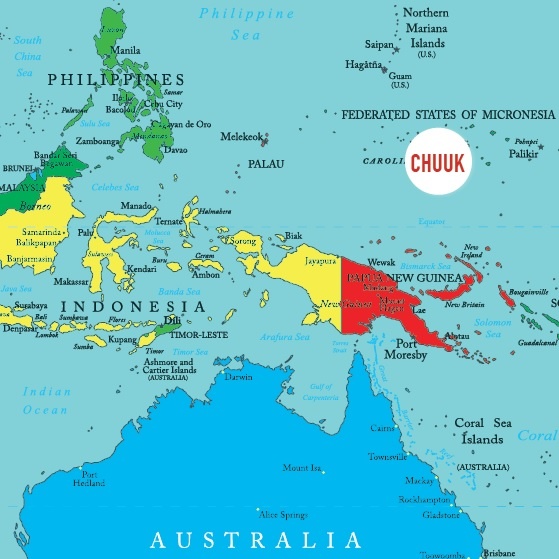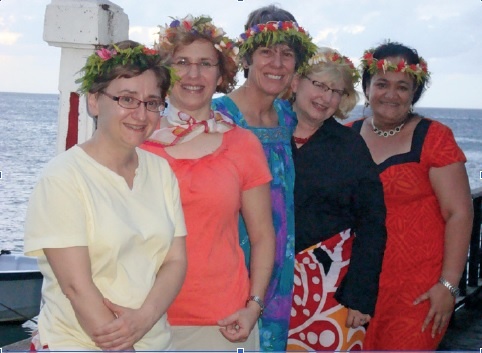This article originally appeared in the spring 2015 issue of InSight magazine published by the University of Iowa College of Public Health.
By Debra Venzke
Often called an “invisible epidemic,” chronic diseases such as heart disease, cancer, and diabetes are the leading causes of death and disability worldwide. Globally, about 347 million people have diabetes, according to the World Health Organization.
The trend is obvious, even in regions such as the Pacific Islands, which struggles with high rates of diabetes despite a reputation as a tropical paradise overflowing with fresh fruits and vegetables.

“Chronic diseases have increased dramatically in the Pacific Islands, where rates of type 2 diabetes are particularly high,” says Linda Snetselaar, CPH professor of epidemiology and director of the college’s Nutrition Center.
In the U.S. Pacific, rates of adult diabetes range from 24 percent in the Federated States of Micronesia to 47 percent in American Samoa. By contrast, the adult diabetes rate in the United States is about 11 percent. Type 2 diabetes is usually associated with excess body weight and physical inactivity. Over time, diabetes can damage the heart, blood vessels, eyes, kidneys, and nerves.
THE CHUUKESE CULTURE
Nutrition is an important component of managing diabetes. A team of researchers led by principal investigator and CPH alumna Nia Aitaoto (PhD ’13) conducted a community-based participatory research project in Chuuk, one of the four island states that comprise the Federated States of Micronesia, to gather information about what helps and hinders people’s adherence to nutritional recommendations.
The co-investigators included Snetselaar and CPH faculty members Shelly Campo, Edith Parker, and Kathleen Janz, along with several other researchers.
About 49,000 people live in Chuuk, and there is also a substantial Chuukese population in Hawaii. The researchers collected information from interviews with Chuukese faith leaders and health care providers.
They also held focus group discussions with individuals with diabetes and caregivers. The researchers are using the findings to develop a nutrition intervention tailored to the Chuukese culture.
Cultural awareness and sensitivity are important when developing interventions, notes Aitaoto, since Western health perspectives often don’t translate to other cultures.
“Pacific Islanders have a collectivistic culture centered around family and community,” says Aitaoto, who works as a consultant with several health-related organizations. “Their view of health is holistic, and family members play an important role in health decisions.”
Religion and spirituality are also very important to Pacific Islanders; about 90 percent of the population belongs to a church. The research team is working closely with faith leaders, “because churches are where people congregate,” says Snetselaar.
A CHANGING DIET
Chuuk like other Pacific Islands, has seen a dramatic change in its dietary habits over the past century. Colonization, wars, and urbanization along with environmental challenges like drought, typhoons, and rising ocean levels have changed the way people eat.

Researchers Shelly Campo, Karen Farris, Kathleen Janz, Linda Snetselaar, and Nia Aitaoto
A diet once based on fish and native plants has largely given way to canned and processed foods. The Western influence on diet became particularly pronounced following the Second World War.
“During World War II, the Japanese army and navy were based in Chuuk, and the U.S. bombed the islands in order to slow the Japanese military,” explains Aitaoto.
Known as Operation Hailstone, the U.S. attack in 1944 involved major bombardment over two days. The islands were cut off from supplies, leading to food shortages and starvation and a legacy of dependence on processed foods.
“The U.S. brought in food after the war,” adds Snetselaar. “That was usually white rice, which is very processed, and meat products such as Spam, which is high in saturated fat. In the grocery stores today, there aren’t a lot of fresh fruits and vegetables. What you see are a lot of canned foods and canned meats.”
More than 70 years after the war, accessing local foods remains difficult: they are more expensive than imported foods, and growing or preparing local food takes extra effort. As one focus-group participant explained:
We live in a tropical island and a lot of people think that we shouldn’t have a problem with fruits and vegetables, but we do. I grew up after the war, so many of our foods were brought in by ships because the bombing destroyed a lot of the vegetation. Today, we are used to eating those canned foods, and they are easy to get and prepare. … For local foods there is a lot of work; farming is hard work, and preparing local food also takes a lot of time.
There are also emotional and motivational barriers, as described by another participant:
Many of us are eating the kinds of foods we ate when we were growing up—mostly imported foods. There is a familiarity with those foods, and they are our comfort foods. We know eating our traditional plant-based foods are good for us, but many times we eat imported foods because they are easy to get, easy to cook, familiar, and comforting food.
Another participant commented:
… I know that I need to eat healthy foods, I know there are many reasons why I can’t do that, but at the core is my own attitude and mentality. I also need the support of my family and church.
BUILDING MOTIVATIONAL SUPPORT
Such perspectives reflect the importance Chuukese culture places on the collective approach, Aitaoto explains. “Involving family members and the church is crucial to getting people to follow nutrition recommendations,” she says.
The researchers’ next step is conducting a culturally appropriate pilot intervention that uses an adaptive version of motivational interviewing, which is an approach that addresses people’s ambivalence to change. Some of the cultural adaptations include involving family members, church leaders, and the community in building motivational support.
“The goal is to use the idea of motivational interviewing, but with a whole new twist based on the Chuukese culture,” Snetselaar says.